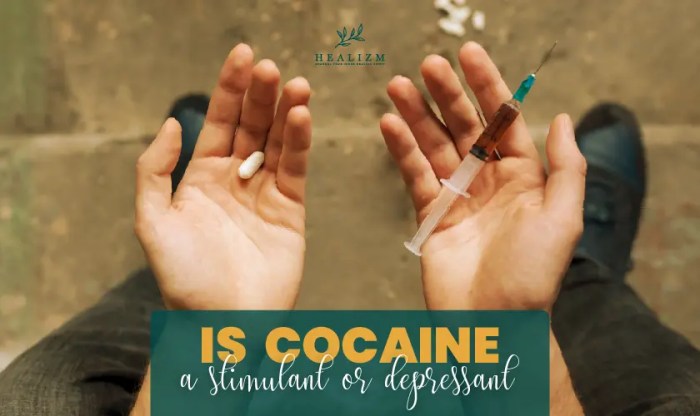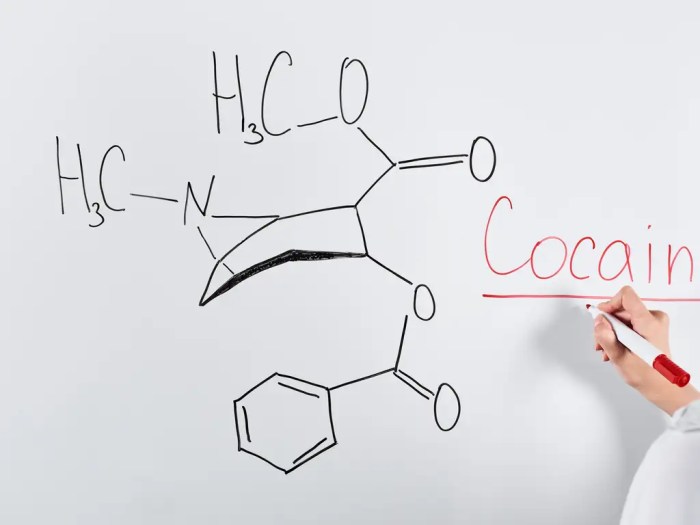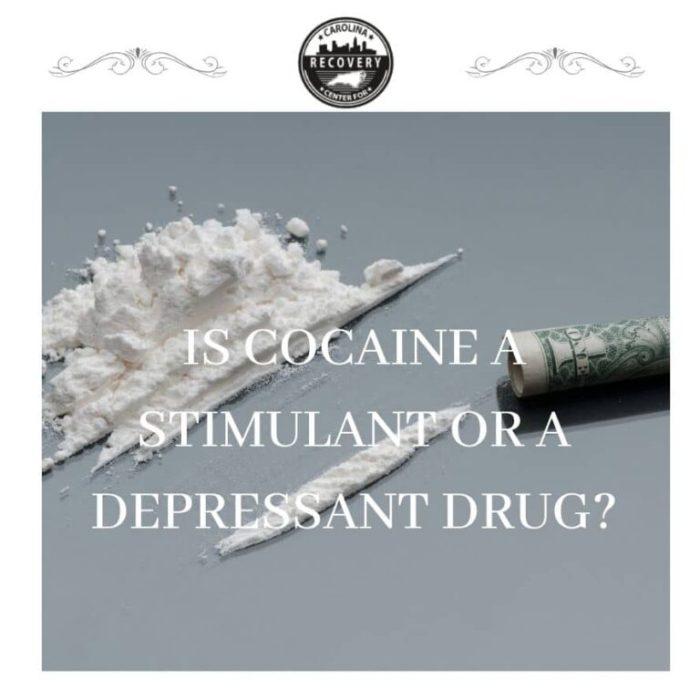Is cocaine a stimulant or depressant? This question sparks a captivating exploration into the enigmatic nature of this illicit substance. Cocaine’s reputation as a potent psychoactive drug demands a thorough examination of its mechanisms of action, physiological effects, and classification within the realm of psychoactive substances.
Delving into the scientific intricacies of cocaine, we will unravel its complex interactions with the central nervous system and neurotransmitters. By comparing its effects to other stimulants and depressants, we will gain a comprehensive understanding of its unique properties and potential consequences.
Definition of Stimulant and Depressant: Is Cocaine A Stimulant Or Depressant

A stimulant is a substance that increases the activity of the central nervous system (CNS), leading to increased alertness, energy, and focus. Depressants, on the other hand, decrease the activity of the CNS, resulting in drowsiness, relaxation, and reduced inhibition.
Cocaine’s Mechanism of Action
Cocaine is a powerful stimulant that acts by blocking the reuptake of neurotransmitters such as dopamine, norepinephrine, and serotonin. This results in an accumulation of these neurotransmitters in the synaptic cleft, leading to increased stimulation of their respective receptors.
Effects of Cocaine on the Body
Short-Term Physiological Effects
- Increased heart rate and blood pressure
- Dilated pupils
- Reduced appetite
- Increased body temperature
- Euphoria and heightened energy
Long-Term Physiological Effects
- Cardiovascular problems
- Neurological damage
- Respiratory problems
- Addiction
- Overdose
Classification of Cocaine

Is Cocaine Primarily a Stimulant or a Depressant?
Cocaine is primarily a stimulant due to its effects on the central nervous system. It increases alertness, energy, and focus, and it does not produce the sedative or relaxing effects typically associated with depressants.
Evidence to Support the Classification
- Cocaine’s mechanism of action involves the inhibition of neurotransmitter reuptake, leading to increased stimulation of the CNS.
- Cocaine’s short-term physiological effects include increased heart rate, dilated pupils, and reduced appetite, which are characteristic of stimulants.
Comparative Effects of Cocaine and Other Stimulants

| Stimulant | Mechanism of Action | Effects |
|---|---|---|
| Cocaine | Blocks neurotransmitter reuptake | Increased heart rate, dilated pupils, reduced appetite, euphoria |
| Amphetamine | Blocks neurotransmitter reuptake | Increased alertness, energy, focus, reduced fatigue |
| Methamphetamine | Blocks neurotransmitter reuptake and releases neurotransmitters | Increased alertness, energy, focus, reduced appetite, euphoria, hallucinations |
Similarities and Differences in Mechanisms of Action, Is cocaine a stimulant or depressant
Cocaine, amphetamine, and methamphetamine all act by blocking the reuptake of neurotransmitters. However, methamphetamine also releases neurotransmitters, which results in a more intense and prolonged stimulation of the CNS.
Comparative Effects of Cocaine and Other Depressants

| Depressant | Mechanism of Action | Effects |
|---|---|---|
| Cocaine | Blocks neurotransmitter reuptake | Increased heart rate, dilated pupils, reduced appetite, euphoria |
| Alcohol | Enhances GABA activity | Drowsiness, relaxation, reduced inhibition, impaired judgment |
| Benzodiazepines | Enhances GABA activity | Drowsiness, relaxation, reduced anxiety, muscle relaxation |
Similarities and Differences in Mechanisms of Action, Is cocaine a stimulant or depressant
Cocaine and other depressants have opposite effects on the CNS. Cocaine increases the activity of the CNS, while depressants decrease it. Cocaine acts by blocking neurotransmitter reuptake, while depressants act by enhancing the activity of GABA, an inhibitory neurotransmitter.
Question Bank
Is cocaine primarily a stimulant or a depressant?
Cocaine’s classification as a stimulant or depressant is a subject of debate, with evidence supporting both perspectives. It possesses properties of both classes of drugs, leading to its categorization as a psychostimulant.
What are the short-term physiological effects of cocaine?
Cocaine’s short-term effects include increased heart rate, blood pressure, and body temperature, dilated pupils, and decreased appetite.
What are the long-term physiological effects of cocaine?
Chronic cocaine use can lead to cardiovascular problems, respiratory issues, malnutrition, and damage to the brain and nervous system.
How is cocaine treated?
Treatment for cocaine addiction involves a combination of behavioral therapy, medication, and support groups.
How can cocaine abuse be prevented?
Prevention strategies include education about the risks of cocaine use, reducing access to the drug, and providing support for individuals at risk.